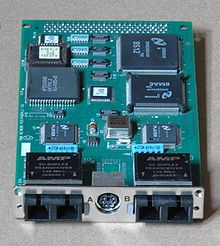- Fiber Distributed Data Interface
-
Fiber Distributed Data Interface (FDDI) provides a 100 Mbit/s optical standard for data transmission in a local area network that can extend in range up to 200 kilometers (120 mi). Although FDDI logical topology is a ring-based token network, it does not use the IEEE 802.5 token ring protocol as its basis; instead, its protocol is derived from the IEEE 802.4 token bus timed token protocol. In addition to covering large geographical areas, FDDI local area networks can support thousands of users. As a standard underlying medium it uses optical fiber, although it can use copper cable, in which case it may be referred to as CDDI (Copper Distributed Data Interface). FDDI offers both a Dual-Attached Station (DAS), counter-rotating token ring topology and a Single-Attached Station (SAS), token bus passing ring topology.
FDDI was considered an attractive campus backbone technology in the early to mid 1990s since existing Ethernet networks only offered 10 Mbit/s transfer speeds and Token Ring networks only offered 4 Mbit/s or 16 Mbit/s speeds. Thus it was the preferred choice of that era for a high-speed backbone, but FDDI has since been effectively obsolesced by fast Ethernet which offered the same 100 Mbit/s speeds, but at a much lower cost and, since 1998, by Gigabit Ethernet due to its speed, and even lower cost, and ubiquity.
FDDI, as a product of American National Standards Institute X3T9.5 (now X3T12), conforms to the Open Systems Interconnection (OSI) model of functional layering of LANs using other protocols. FDDI-II, a version of FDDI, adds the capability to add circuit-switched service to the network so that it can also handle voice and video signals. Work has started to connect FDDI networks to the developing Synchronous Optical Network (SONET).
A FDDI network contains two rings, one as a secondary backup in case the primary ring fails. The primary ring offers up to 100 Mbit/s capacity. When a network has no requirement for the secondary ring to do backup, it can also carry data, extending capacity to 200 Mbit/s. The single ring can extend the maximum distance; a dual ring can extend 100 km (62 mi). FDDI has a larger maximum-frame size (4,352 bytes) than standard 100 Mbit/s Ethernet which only supports a maximum-frame size of 1,500 bytes, allowing better throughput.
Designers normally construct FDDI rings in the form of a "dual ring of trees" (see network topology). A small number of devices (typically infrastructure devices such as routers and concentrators rather than host computers) connect to both rings - hence the term "dual-attached". Host computers then connect as single-attached devices to the routers or concentrators. The dual ring in its most degenerate form simply collapses into a single device. Typically, a computer-room contains the whole dual ring, although some implementations have deployed FDDI as a Metropolitan area network.
Mitigating failure
FDDI requires this network topology because the dual ring actually passes through each connected device and requires each such device to remain continuously operational. The standard actually allows for optical bypasses, but network engineers consider these unreliable and error-prone. Devices such as workstations and minicomputers that might not come under the control of the network managers are not suitable for connection to the dual ring.
As an alternative to using a dual-attached connection, a workstation can obtain the same degree of resilience through a dual-homed connection made simultaneously to two separate devices in the same FDDI ring. One of the connections becomes active while the other one is automatically blocked. If the first connection fails, the backup link takes over with no perceptible delay.
Standards
FDDI standards include:
- ANSI X3.139-1987, Media Access Control (MAC) — also ISO 9314-2
- ANSI X3.148-1988, Physical Layer Protocol (PHY) — also ISO 9314-1
- ANSI X3.166-1989, Physical Medium Dependent (PMD) — also ISO 9314-3
- ANSI X3.184-1993, Single Mode Fiber Physical Medium Dependent (SMF-PMD) — also ISO 9314-4
- ANSI X3.229-1994, Station Management (SMT) — also ISO 9314-6
References
 This article incorporates public domain material from the General Services Administration document "Federal Standard 1037C".
This article incorporates public domain material from the General Services Administration document "Federal Standard 1037C".- This article was originally based on material from the Free On-line Dictionary of Computing, which is licensed under the GFDL.
Categories:- Network protocols
- Link protocols
Wikimedia Foundation. 2010.

